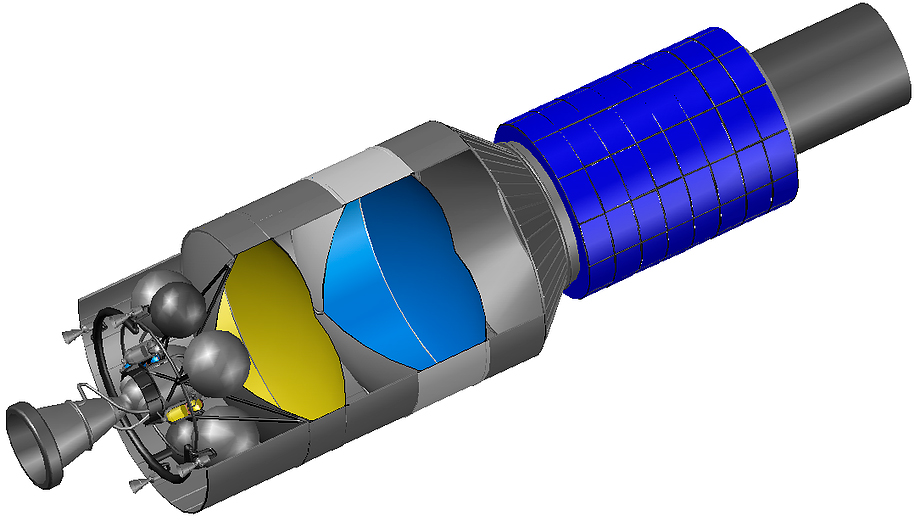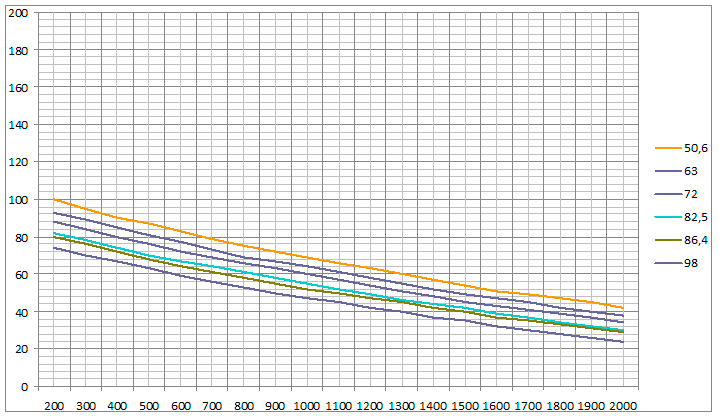Aldan microsat launch vehicle

The project of Aldan two-stage space launch vehicle (LV) with payload of 100 kg, powered by environmentally safe propellants, was positively assessed by the experts from the Space Technologies and Telecommunications Cluster of the Skolkovo Foundation.
Simple and cost efficient technical solutions are to be applied for the creation of the LV.
- Gross mass — 8.1 metric tons.
- Payload — 100 kg to low Earth orbit (LEO).
- 1st stage (diameter — 1.2 m) — 4 vernier thrusters from RD-108A.
- 2nd stage (diameter — 1.2 m) — engine based on vernier thruster.
- Propellant tanks — smooth-walled, made of AMg6 aluminium-magnesium alloy.
- Height with payload fairing — 14.4 m.
Why a small launch vehicle?
The project is aimed at reducing lead time and costs of launch to LEO for microsats and nanosats.
The last decade has seen a trend of shifting from heavy satellites weighing multiple tons to satellites in micro- and nano- classes.
The development of microsat (10–100 kg), smallsat (100–500 kg) and nanosat (1–10 kg) platforms is seen around the world. Both private and state-owned companies and educational institutions are involved in the creation of such satellites. Russian private companies Dauria Aerospace and Sputnix also launch microsats and nanosats.
Currently there is no microsat launch vehicle with payload of 100 kg in Russia.
Payload of a small-lift launch vehicle (Soyuz-2-1v, Rockot etc.) is excessive for launching individual microsats and nanosats, resulting in the need for cluster launches. This practice is inconvenient for customers having individual satellites.
- Firefly Space Systems
- Virgin Galactic
- Interorbital Systems
- Rocket Lab
There is growing need for the creation of a relatively cheap microsat launch vehicle specifically for such spacecraft.
Currently many countries and private companies are working in this area, yet none of them is succeeded.
When using medium-lift and small-lift launch vehicles to launch microsats and nanosats as secondary payloads, the primary payload preparation schedule slips sometimes, resulting in launch delays for the secondary payloads. Adherence to a launch schedule is particularly critical when deploying orbital constellations of multiple spacecraft.
The proposed project solves the problem of short lead time and convenience for microsat and nanosat launches.
Small satellite launches in the USA
- Planetary Resources company announced signing a contract with Virgin Galactic for launch of four Arkyd-100 commercial space telescopes to study asteroids.
- Skybox Imaging company from California paid $91 mln to launch at least two remote sensing satellites. On November 21, 2013 the first satellite named SkySat-1 was launched within a cluster by Dnepr launch vehicle from Yasny launch base (Russia). On July 8, 2014 the second satellite named SkySat-2 was launched within a cluster by Soyuz-2-1b with Fregat space tug from Baikonur Cosmodrome (Kazakhstan).
- GeoOptics Inc. company from California wants to use a small-lift launch vehicle to deploy a satellite of spacecraft in orbit for environmental monitoring.
- Spaceflight Industries private aerospace corporation from Seattle plans to use LauncherOne to launch various payloads weighing from 1 to 300 kg.
Rocket Lab company (USA, New Zealand) signed contracts for 30 launches after it announced its new space launch vehicle with payload of 110 kg.
The problem with launches of small satellites abroad is a high price (above $15 mln) for launch.
High costs of smallsat launch vehicle development are also notable. Today the problem of high costs of space launches is one of the hurdles in the path of microsat and nanosat technology development.
Solution to the problem
The project solves the problem of reducing lead time and costs of space launch for small spacecraft by creating a new microsat launch vehicle using four vernier thrusters of mass-produced RD-108A engine on the first stage, and one vernier thruster of the same type on the second stage, propellant feed system based on pneumatic pump, with simple technological solutions and vehicle assembly by civilian manufacturer.
- We widely use proven technological solutions - currently manufactured vernier thrusters of a rocket engine for the first stage, and one more such thruster as a basis for the second stage engine. The first stage features four vernier thrusters of RD-108A engine (used on the central core of Soyuz launch vehicle). The second stage features an engine based on vernier thruster of RD-108A.
- Pneumatic pump is used in the propellant feed system, thus allowing to avoid using a relatively expensive turbopump.
- The basis of the project is optimization for launch costs and launch vehicle return on investment, rather than increasing payload fraction.
- Technologically simple structural solutions are used for LV - smooth-walled tanks made of widely-used AMg6 aluminium-magnesium alloy, flight control by gas thrusters (no need to swivel the main engines).
- Compact flight control system of own design, based on MEMS angular rate sensors and ARM microcontrollers, is expected to be used.
Taking into account the fact that the fraction of propellant cost is relatively small as compared to the cost of the launch vehicle (about 4–5%), we expect to create a launch vehicle meeting the desired specifications not by complicating the design (by using complicated technological solutions, additional stages), but due to simplifying it — reducing the number of stages to two and slightly increasing the mass of propellants.
We propose a project of manufacturable and simple to produce microsat launch vehicle optimized for launch costs. The classical approach to LV design results in that optimization of the design is performed by maximizing the payload fraction. This leads to complicated technological solutions and the increase of time and costs of LV development.
A possibility is considered for manufacturing the propellant tanks for the vehicle by a civilian enterprise outside the space industry. Talks were held with the management of OJSC Kalibrovsky Zavod (manufacturing plant), agreement is reached.
Reusability
In the future implementation of the first stage recovery is possible:
Phase 1. Testing of the first stage recovery using capture by helicopter is planned, including the use of unmanned multirotors.
Phase 2 — by using folding fiberglass blades and autorotation.
Partial reusability will not require significant revision of the power plant, since engines of both the first and second stages have MTTF exceeding the burn time.
In general, the innovation of approach is considerable simplification of the end product, use of mass-produced components and a special propellant feed system, and the flight control system of our own design.
Technological trends in the subject area
- Demand for microsat launch vehicles emerges as a result of reducing the mass of spacecraft.
-
The advent of microsat launch vehicles abroad, such as:
- LauncherOne project by American company Virgin Galactic with payload of 225 kg to LEO. The project was announced in 2012, the real launches are planned after 2016.
- Pegasus launch vehicle by American company Orbital Sciences Corporation with payload of 443 kg to LEO. 37 out of 42 launches were successful.
- Development of Electron launch vehicle with payload of 110 kg in New Zealand. Rocket Lab company has the first 30 launches reserved, and the first test launch will occur in 2016.
- A project by FireFly Space Systems - Firefly α powered by methane with payload of 400 kg. Currently the company is hiring.
- Interorbital Systems company is working on a modular launch vehicle called NEPTUNE, which will be capable to launch up to 50 kg to LEO depending on the number of modules - projects #5, #7. The company also plans to design a launch vehicle for 1000 kg from a large number of modules. The company adheres to the ideology of OTRAG project developed in 1970-s.
- Maximum streamlining for ground services - independent navigation, digital control systems, reducing launch staff.
- Reusability for first stages of LV. American company SpaceX is busy with launch vehicle reusability program. Although it has not yet managed to recover and reuse any part of the launch vehicle, the work goes on. As of today, tests are completed for Grasshopper technology-demonstrator vehicle and began for the reusable first stage of Falcon 9R.
Market trends
The main trend on the market is providing launch services for companies with small spacecraft, as requested. The advent of private companies in the space sector marked the transition from increasing the payload fraction at all costs to launch costs optimization. This is achieved by reducing the cost of creating new launch vehicles thanks to the wide use of computer-aided modeling and new means of ground testing.
Besides, companies aim to reduce the costs of prelaunch processing and launch facilities.
Launch vehicle design
Cutaway drawing of the Aldan first stage

Cutaway drawing of the Aldan second stage

The project is based on employing vernier thrusters of a mass-produced and highly reliable rocket engine, special propellant feed system with pneumatic pump, streamlined technological solutions, and flight control system of our own design.
4 vernier thrusters of RD-108A engine with pneumatic pump are to be used on the first stage of the vehicle. Liquid-propellant rocket engine RD-108A is powered by environmentally safe propellants — oxygen and kerosene. This engine is mass-produced since 1957 and proved its reliability.
Testing of the propellant feed system is planned on a test range of Geodeziya Research Institute — preliminary negotiations are completed.
One vernier thruster of RD-108A is to be used on the second stage.
Recovery system mockups are to be installed on the vehicle for the early test flights. Its gradual introduction will occur after commissioning the launch vehicle.
- Use of a small hypersonic drogue parachute to slow the first stage right after its separation from the launch vehicle. This innovation, not used before, allows to bring the impact site closer to the launch site, and later shorten the distance between the landing site and the cosmodrome.
- Use of regular gas thrusters powered by the remaining nitrogen for attitude control during descent and landing. This allows to reduce the area of probable impact (landing) of the stage.
- Use of embedded beacons and a parachute system allows to find the stage at high altitudes in the atmosphere in order to intercept it with a helicopter (Mi-8) or a multirotor drone prior to landing. In this case the stage can be reused after a brief period of time. This significantly reduces the total launch cost.
A compact flight control system of our own design based on MEMS angular rate sensors and ARM microcontrollers is to be used in the project.
We expect to refuse of traditional milled tanks in the project due to manufacturing complexity. Smooth-walled strengthened shells are to be used instead.
Transportation
Engineering solutions incorporated in the launch vehicle design allow to move its sections by any means of transport - such as aircraft, trains, trucks in a large 40-foot container.
- railroad — loads while moving a freight car on jointed track, shock load;
- aircraft — landing shock;
- truck — loads while accelerating and braking.
An option of launching from an unprepared site within 3 days after launch equipment delivery is considered for the later phases of the project. In the first phase launches are possible from Kapustin Yar launch site.
Technical description of Aldan launch vehicle
Aldan launch vehicle consists of two rocket modules with tandem staging design. All stages feature liquid-propellant rocket engines powered by environmentally safe propellants: oxidizer — liquid oxygen, fuel — kerosene.
The rocket module of the first stage consists of interstage, oxidizer tank, instrumentation module, fuel tank and tail section. The tanks for oxidizer and fuel are cylindrical, smooth-walled, made of AMg6 aluminium-magnesium alloy. The tail section includes liquid nitrogen tank and the main engine. The engine is composed of vernier thrusters of RD-108A, pneumatic pump is used as a propellant feed system. Tank pressurization and powering the pump are performed by the gasification of liquid nitrogen.
Pneumatic pump features two chambers connected by two valves (three-state) to each other and to pipelines for the intake of fluid and pressurizing gas. The lower chamber volume is twice the upper one. Working cycle is two-stroke. During the first stroke the upper chamber is filled with fuel. After it is filled the valves are switched: the upper chamber gets connected with the lower one, and during the second stroke the upper chamber is fed by gas under the operating pressure of fuel. After emptying the upper chamber the cycle repeats.
Flight control of the first stage for all three axes is performed by vernier thrusters powered by exhausted gas from the pneumatic pump.
Rocket module of the second stage consists of instrumentation module, oxidizer tank, intertank section, fuel tank and tail section. The tanks for oxidizer and fuel are cylindrical, smooth-walled, made of AMg6 aluminium-magnesium alloy. The tail section includes the main engine, based on vernier thruster of RD-108A, and liquid nitrogen tanks for pressurization and powering the pneumatic pump for the propellant feed.
Flight control for all three axes is performed by vernier thrusters powered by exhausted gas from the pneumatic pump.
Stage separation is 'cold' and involves explosive bolts and gas thrusters (powered by exhausted gas from the pneumatic pump) to settle the propellant.
Aldan performance chart

Vertical axis — payload launched into orbit. Horizontal axis — altitude of target circular orbit. Orbital inclinations: 50.6 degrees — Kapustin Yar launch site, 63, 72, 82.5, 86.4, 98 degrees — Plesetsk Cosmodrome.
The circular orbits with altitudes from 200 to 1400 km are reached with two impulse flight profile. The second stage should provide the total of least three engine burns while operating (initial parking orbit insertion, impulses at the perigee and apogee of the transfer orbit), this is supported by the engine used, since it is designed for a larger number of ignitions.
Costs and profits estimation
Launch preparation cost — $0.2 mln
Launch cost — $1.2 mln
Cost for payload in orbit — ~$12K per kg
Costs for the launch vehicle creation + ground testing:
18 * $1 mln = $18 mln
Number of commercial launches per year — 4
Price per launch — $4 mln
Price per 1 kg in orbit — $40,000
Profit per launch — $2.8 mln
Therefore, after 2.5 years and 9 launches the project reaches the break-even point and becomes profitable.

